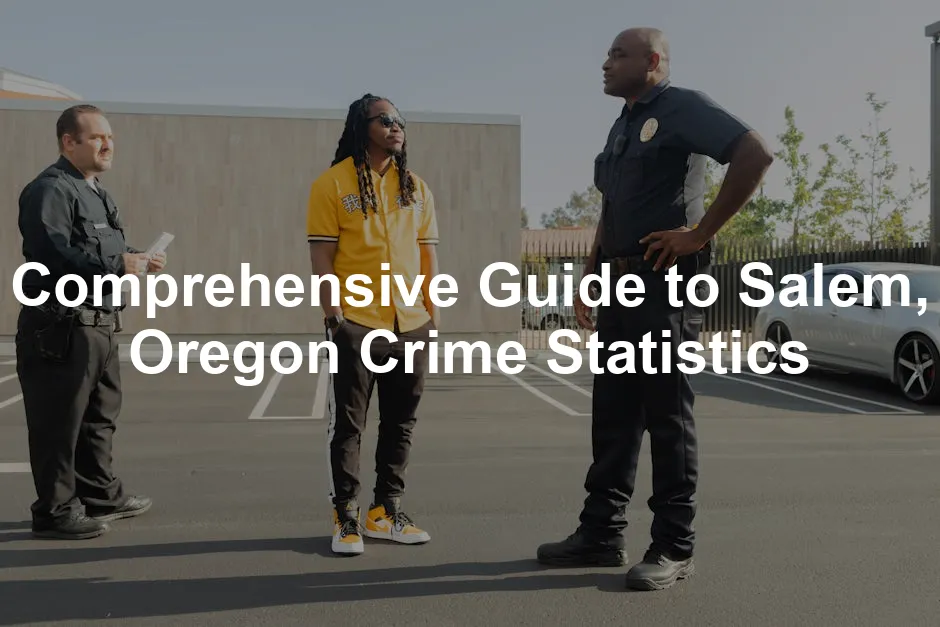Introduction
Understanding crime statistics in Salem, Oregon, is crucial. This data provides insights into safety for residents and visitors alike. Whether you’re considering moving to Salem or just visiting, these statistics help gauge the city’s livability. To dive deeper into how crime affects communities, check out “Crime and Community: A New Perspective on Safety”.
Salem has seen varying crime trends over the years. Recently, crime rates have sparked concern among community members. Awareness of crime rates can lead to better community safety and proactive measures. Knowledge is power, especially when it comes to protecting ourselves and our loved ones.
For residents, this data is more than numbers. It reflects the quality of life and the community’s safety. For potential movers, it can influence decisions about settling down. Even tourists can benefit from understanding the local environment. After all, nobody wants to be in the wrong place at the wrong time. If you’re looking for a deeper understanding of crime, consider reading “The Crime Book: Big Ideas Simply Explained”.
In recent years, trends indicate fluctuations in both violent and property crimes. Violence rates have seen upward spikes, while property crimes show a decrease. Staying informed about these shifts is vital for everyone involved. Ultimately, understanding crime statistics is about fostering a safer community.

Overview of Salem’s Crime Landscape
Historical Context
Over the past decade, Salem has experienced notable crime trends. Initially, violent crime rates surged, alarming locals. Between 2009 and 2019, violent crime increased significantly. However, property crime rates fluctuated, showing signs of decline in recent years.
In 2023, reports highlighted a mixed bag of trends. While violent crimes dipped slightly, they still remained higher than a decade ago. Homicides reached a 15-year high, adding to the community’s concerns. This pattern raises questions about the underlying causes. To better understand societal challenges, consider reading “The New Jim Crow: Mass Incarceration in the Age of Colorblindness”.
Property crime, on the other hand, showed a different trajectory. It reached its lowest rate in 15 years, reflecting community efforts to enhance safety. Yet, concerns linger about how to address ongoing issues, particularly in high-crime areas. Understanding these historical patterns is essential for grasping the current crime landscape.

Current Crime Statistics
As of 2023, Salem’s crime statistics paint a vivid picture. The city has a crime rate of 42 per 1,000 residents, making it one of the more dangerous cities in the U.S. With a violent crime rate of 5 per 1,000 residents, the chances of becoming a victim are roughly 1 in 199. Comparatively, this is higher than the national average.
Property crime rates are even more pronounced. With a staggering 37 per 1,000 residents, the likelihood of being a victim is about 1 in 27. When comparing Salem’s crime statistics to national averages, it’s evident that the city faces significant challenges. More than 93% of communities in Oregon report lower crime rates than Salem. To stay safe, consider investing in a Personal Safety Alarm Keychain for peace of mind!
Sources such as the FBI and local police reports provide the backbone of this data. It’s crucial for residents to stay informed and vigilant. Armed with knowledge, the community can work together to enhance safety and awareness. Understanding these current statistics is key to fostering a safer Salem for all.

For a comprehensive analysis of crime data in Salem, check out this Winston Salem crime statistics.
Breakdown of Crime Types
Violent Crime
Violent crime includes offenses that involve force or the threat of force. This category encompasses murder, rape, robbery, and assault. In Salem, the statistics for violent crime tell a compelling story.
In 2023, there were 890 reported violent crimes in Salem. This breaks down to:
- Murder: 7 incidents
- Rape: 46 incidents
- Robbery: 176 incidents
- Assault: 661 incidents
When we compare these figures, Salem’s violent crime rate stands at 5 per 1,000 residents. This is higher than the Oregon average of 3.42 and the national median of 4. This indicates that residents face a higher risk of experiencing violent crime in Salem compared to other areas.
Looking at trends, violent crime in Salem has shown a concerning increase over the past decade. Reports indicate that violent crime rates have surged nearly 61% since 2014. While there was a slight dip in 2023, the overall trend remains upward. Homicides reached a 15-year high this past year, contributing to community anxiety. For those interested in understanding the psychology behind such trends, consider reading “The Body Keeps the Score: Brain, Mind, and Body in the Healing of Trauma”.

Property Crime
Property crime refers to offenses that do not involve force or the threat of force against a person. This category includes burglary, theft, and motor vehicle theft. In Salem, property crime statistics present a different picture than violent crime.
In total, 6,548 property crimes were reported in 2023. Here’s how these crimes break down:
- Burglary: 753 incidents
- Larceny (theft over $50): 4,598 incidents
- Motor Vehicle Theft: 1,197 incidents
Salem’s property crime rate is an eye-popping 37 per 1,000 residents, which starkly contrasts with the national average of 20. The chances of becoming a victim of property crime in Salem are about 1 in 27, a statistic that is significantly alarming for residents. To protect your home, consider installing a Home Security Camera System.
Interestingly, property crime rates in Salem have dipped to their lowest levels in 15 years. Despite the overall crime rate being high, local initiatives aimed at crime prevention are starting to show positive results. However, the steady rate of motor vehicle theft remains a significant concern, as Salem has one of the highest rates in the nation.

Crime Rate Comparison
To better understand Salem’s crime landscape, it’s helpful to compare its rates with similar cities. Below is a comparative table showing the violent and property crime rates per 1,000 residents for Salem, Oregon, and other similar cities.
| City | Violent Crime Rate | Property Crime Rate |
|---|---|---|
| Salem, OR | 5.01 | 36.89 |
| Eugene, OR | 4.70 | 29.00 |
| Gresham, OR | 4.42 | 31.09 |
| Springfield, OR | 3.59 | 27.89 |
| Albany, OR | 3.40 | 23.10 |
From this comparison, it’s clear that Salem faces more violent and property crime than its counterparts. The data suggests that while Salem’s violent crime rate is relatively close to Eugene’s, it surpasses many other cities in Oregon. The property crime landscape shows even more disparity, with Salem significantly higher than the averages of Eugene and Gresham.
Understanding these statistics provides valuable insights into the safety of Salem for current residents and potential movers. While community efforts are underway to address these issues, awareness and vigilance remain critical in fostering a safer environment. If you’re serious about personal safety, consider a Smart Doorbell Camera for your home.

Neighborhood Crime Analysis
High-Crime Areas
Salem, Oregon, has neighborhoods that consistently score high on crime statistics. Areas like Northeast Salem and parts of South Salem see more incidents than others. Recent data reveals that Northeast Salem has a violent crime rate of about 8 per 1,000 residents. In contrast, South Salem also struggles, particularly with property crimes.
Several factors contribute to these troubling trends. Economic challenges come into play, as lower-income areas often experience higher crime rates. Limited access to quality education and job opportunities exacerbates the situation. Additionally, the presence of gang activity in these neighborhoods creates an environment ripe for violence.
According to a recent report, 70% of violent crimes in Salem occur in just a handful of neighborhoods. This concentration can be alarming for residents. Awareness of these areas is crucial, especially for those considering a move to Salem.

Safer Neighborhoods
On the flip side, Salem also boasts some neighborhoods with notably lower crime rates. Areas like West Salem and the Eola district have become popular for families looking for safer options. West Salem, in particular, has a property crime rate of only 15 per 1,000 residents. This is significantly lower than the city’s average.
Several factors contribute to the safety of these neighborhoods. Strong community involvement plays a vital role. Residents often participate in neighborhood watch programs and engage with law enforcement. Additionally, these areas tend to have better access to schools and parks, fostering a sense of community pride.
For residents and visitors alike, exploring these safer neighborhoods can be a delightful experience. West Salem offers beautiful parks and family-friendly activities, while Eola features charming local shops and eateries. If you’re looking to visit or even settle down, consider these areas. Stay aware, stay safe, and enjoy all that Salem has to offer! If you’re into fitness and relaxation, a Yoga Mat for Stress Relief might just be what you need!

Community Sentiment and Safety Perception
Resident Surveys
Understanding how residents feel about safety is vital for community well-being. Recent surveys indicate a divided sentiment among Salem’s population. Approximately 40% of residents feel safe walking alone at night, while the remaining 60% express concerns about crime rates.
Interestingly, perceptions of safety vary significantly among demographic groups. Younger residents tend to feel more anxious, often attributing their worries to increased media coverage of crime. In contrast, older residents generally report feeling safer, likely due to greater familiarity with the community and its dynamics.

Law Enforcement Effectiveness
The effectiveness of local law enforcement is another topic of discussion among Salem residents. Many community members report that police visibility has improved, with 46% stating that officers are very responsive to incidents. However, others express frustration, suggesting that response times can vary greatly, especially during peak hours.
Statistics on police presence reveal there are approximately 1.4 officers per 1,000 residents in Salem. This is lower than the national average, raising concerns about resource allocation. While many appreciate the efforts of local law enforcement, the community continues to advocate for more officers to enhance safety.
Overall, community feedback reflects a mix of appreciation and concern regarding law enforcement’s role in maintaining safety. As Salem evolves, so too must its strategies for combating crime and fostering a sense of security for all residents.

Year-Over-Year Trends
Statistical Changes
Crime rates in Salem, Oregon, have fluctuated significantly over the years. The latest data reveals a crime rate of 42 per 1,000 residents, which is notably higher than the national average. In 2023, the city recorded a total of 890 violent crimes, translating to a rate of 5 per 1,000 residents. This is an increase from previous years, reflecting a concerning trend in violent crime.
Specifically, the number of homicides reached a 15-year high, with 10 reported cases. This represents an increase from eight in 2022. Other violent crimes, such as assaults and robberies, have also seen a rise. Assaults accounted for 661 incidents, while robberies totaled 176. On the flip side, property crimes saw a decrease, with 6,548 incidents reported, marking the lowest rate in over a decade.
Comparing these figures year-over-year shows a mixed bag. From 2022 to 2023, there was a slight decline in overall violent crimes, despite the alarming rise in homicide numbers. Property crime rates dropped by approximately 3% during the same period.

Discussion of Trends
Several factors may contribute to these observed trends. Economic conditions play a crucial role in influencing crime rates. With an unemployment rate of 3.8%, Salem’s job market is relatively stable, but financial insecurity can still drive individuals to commit crimes. Limited access to affordable housing exacerbates these issues, particularly in lower-income neighborhoods.
Community initiatives also impact crime statistics. The Salem Police Department has launched programs like the Community Violence Reduction Initiative, aimed at fostering partnerships with local organizations to address violence. These efforts have resulted in increased community engagement and awareness. If you’re looking to learn more about personal development and community engagement, consider reading “The 7 Habits of Highly Effective People”.
However, disparities in perceptions of safety exist among residents. Young people often express more anxiety about crime, influenced by media coverage and social media discussions. Older residents, in contrast, tend to feel safer, possibly due to their familiarity with the neighborhoods and community dynamics.
Understanding these trends offers insight into the underlying causes of crime in Salem. By addressing economic and social factors, as well as enhancing community initiatives, there is potential for a safer environment for all residents.

Safety Initiatives and Community Programs
Law Enforcement Initiatives
To combat crime, Salem’s law enforcement has implemented several proactive strategies. The Community Violence Reduction Initiative stands out as a key program aimed at reducing violent incidents within the city. This initiative focuses on collaboration between law enforcement and community organizations, fostering relationships to better address local concerns.
The Salem Police Department is also investing in community policing efforts. Officers engage with residents through outreach programs, public forums, and educational workshops. These efforts aim to build trust and enhance communication between law enforcement and the community.
Additionally, partnerships with local organizations have been instrumental. By working with nonprofits and community groups, the police can better understand the specific needs and challenges faced by different neighborhoods. This approach helps tailor responses to crime prevention and fosters a collaborative environment. For those interested in emergency preparedness, a Emergency Preparedness Kit is a must-have!

Community Engagement
Community engagement plays a vital role in improving safety in Salem. Neighborhood watch programs have gained traction, empowering residents to take an active role in crime prevention. These programs encourage neighbors to look out for one another, fostering a sense of belonging and vigilance.
Public forums provide a platform for residents to voice concerns and discuss safety issues. These gatherings not only enhance community awareness but also allow local government officials to address specific needs effectively. Engaging citizens in discussions about crime prevention strategies creates a shared responsibility for safety.
The local government also supports initiatives that promote community safety. By investing in public spaces, improving lighting, and enhancing recreational areas, Salem is working towards creating a more secure environment. A united effort between law enforcement, local government, and community members is essential in combating crime and making Salem a safer place for everyone. If you’re interested in personal safety tools, a Pepper Spray for Self Defense could be a valuable addition to your personal safety plan.

FAQs
What are the safest neighborhoods in Salem?
Some of the safest neighborhoods include West Salem and the Eola district. These areas boast lower crime rates and strong community engagement.
How does Salem compare to other cities in Oregon in terms of crime rates?
Salem has a higher crime rate than many other Oregon cities. More than 93% of communities in the state report lower crime rates than Salem.
What should I do if I become a victim of crime in Salem?
If you become a victim, contact local law enforcement immediately. Reporting the incident helps authorities address crime effectively.
How can residents contribute to community safety efforts?
Residents can join neighborhood watch programs, attend community meetings, and engage with local law enforcement. Being active in safety initiatives fosters a sense of shared responsibility.
Please let us know what you think about our content by leaving a comment down below!
Thank you for reading till here 🙂
All images from Pexels




